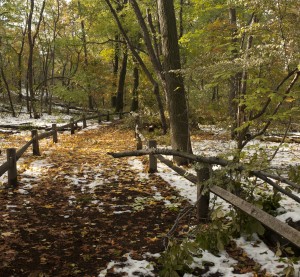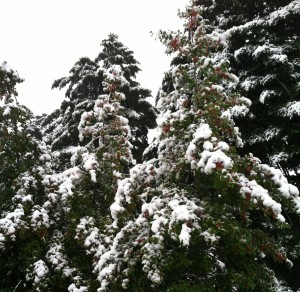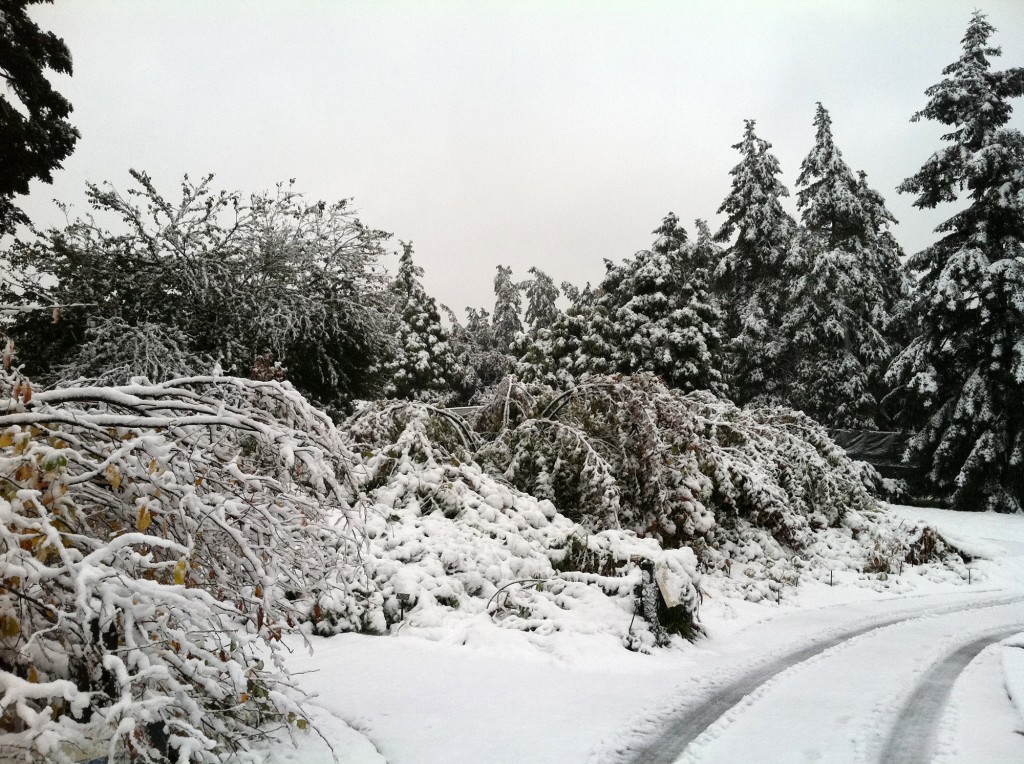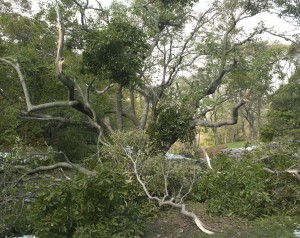Revisiting ‘Snow-tober’ — No Tree Left Behind
Posted in Around the Garden on January 3 2012, by Sonia Uyterhoeven
Sonia Uyterhoeven is the NYBG’s Gardener for Public Education.
 Picking up from last week’s weird weather exposé, I would like to take time today to reflect on the unexpected snow storm that hit New York and New England on October 29th. While the damage from hurricane Irene was devastating for many areas, the damage from the snow storm was far worse for the Metropolitan New York area. There wasn’t a tree that was safe from its perils.
Picking up from last week’s weird weather exposé, I would like to take time today to reflect on the unexpected snow storm that hit New York and New England on October 29th. While the damage from hurricane Irene was devastating for many areas, the damage from the snow storm was far worse for the Metropolitan New York area. There wasn’t a tree that was safe from its perils.
The aftermath of the snow storm resulted in one of the most extensive clean-up operations I have experienced in my seven-year tenure at The New York Botanical Garden, and it is still ongoing. Large sections of the grounds were closed off until they were deemed safe. The public came in hordes to see both the unexpected winter wonderland and the magnificent scale of destruction. If the power and fury of nature evokes awe, she was in fine form that day.
So why was the storm so severe? We need to step back in time and recall the weather preceding the storm; it seems as if Mother Nature made a change to her personal calendar this year without telling anyone. The chilly autumn nights never came and throughout the months of September and October–due to warm and wet weather–plants continued to thrive rather than slowing down and initiating their dormancy process.
 In a normal year, the trees in this area are either partially or fully defoliated by October 29. Seasonal cues signal the leaves that it is time to start the process of senescence. We become aware of this process through the highly visual and spectacular show of fall color, but behind the scenes other things are happening in the leaves. As the balance of hormones in the tree starts to shift, the cell wall at the base of each leaf stalk–the petiole–begins to weaken. Once the cells in what is called the “abscission zone” are weakened, any heavy wind, rain, or snowfall can bring the leaf tumbling to the ground.
In a normal year, the trees in this area are either partially or fully defoliated by October 29. Seasonal cues signal the leaves that it is time to start the process of senescence. We become aware of this process through the highly visual and spectacular show of fall color, but behind the scenes other things are happening in the leaves. As the balance of hormones in the tree starts to shift, the cell wall at the base of each leaf stalk–the petiole–begins to weaken. Once the cells in what is called the “abscission zone” are weakened, any heavy wind, rain, or snowfall can bring the leaf tumbling to the ground.
This year the foliage on the trees was healthy and green by the 29th, and the petioles were still firmly attached to the branches. The weather had been so warm (particularly the overnight temperatures) that the foliage hadn’t begun to shut down for the season.
Trees, like other structures, have what is called a load-bearing capacity. This is the amount of strain that the wood can handle without breaking. The size and the amount of leaves on a tree, the size of the buds, and the shape and distribution of the branches are each variables influencing the weight of a given tree’s limbs. In this case, the effect of the heavy snow clinging to each tree was compounded by the fact that the majority of the deciduous trees still had all of their foliage, and the combined weight proved too much. It was an eerie experience to be at the Garden that day.

When I stepped outside at 2 p.m. all was white, still, and quiet. But at a certain point the stillness was interrupted by large cracks and crashes echoing through the Garden. Sirens were audible in the distance as branches started failing on the streets in the Bronx. At the NYBG, our trees are planted in collections that form woody groves of the same genus and/or species; you could hear when the load capacity was reached, as–one by one–branches in a collection would fall, as if synchronized like rows of dominoes.
 Our Magnolia collection was hit particularly hard. One of the causes was that our old saucer magnolias (Magnolia soulangiana) had large, broad branches that stretched out to form a beautiful architecture. The combination of large horizontal branches, full buds, and foliage covered with snow proved too much for the trees and they broke from the strain. In a more predictable season this deciduous tree greets the snow without the added weight of its foliage.
Our Magnolia collection was hit particularly hard. One of the causes was that our old saucer magnolias (Magnolia soulangiana) had large, broad branches that stretched out to form a beautiful architecture. The combination of large horizontal branches, full buds, and foliage covered with snow proved too much for the trees and they broke from the strain. In a more predictable season this deciduous tree greets the snow without the added weight of its foliage.
Elsewhere in the Garden, the American sweetgums (Liquidambar styraciflua) with their heavy fruit set and large leaves splintered and lost branches. A tall white oak (Quercus alba) lost one-third of its canopy when a number of structural branches were ripped off. For several weeks piles of fallen limbs were lined up by the sides of our utility roads, waiting to make their way to the pile of wood chips that now stands as testament to the extensive damage suffered here.
But in spite of everything that happened, nature is truly resilient. During that snowy day I walked around the Home Gardening Center and saw a multi-stemmed Himalayan birch (Betula utilis var. jacquemontii) and Kousa dogwoods (Cornus kousa) bent over and lying on the ground. I thought they were goners. However, these young specimens shook off the snow and were upright and as good as new no more than two days later. Next week we will get a bit more hands-on with respect to this event, viewing the storm through the eyes of an arborist.
To be continued….

